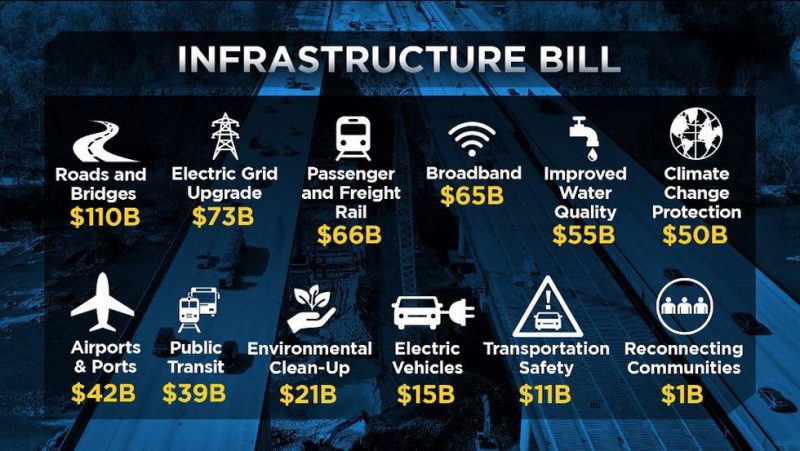Much has been made about the government’s ability, then inability, and now likelihood to bring the long-discussed Infrastructure Bill to fruition. The bill is bipartisan, a word we use less and less, as it passed 228-206 with 13 Republicans voting “Yes” in the House and 69-30 in the Senate, including 19 GOP senators. Infrastructure PR is heating up, and upon signature from President Biden, the deal is done and is going to have a significant impact on a number of industries such as sustainability, B2B tech and real estate / engineering, to name a few.
To simplify, I’m first going to share what’s in the bill, using a short list originally published by Axios:
- $110 billion toward roads, bridges and other much-needed infrastructure fix-ups across the country; $40 billion is new funding for bridge repair, replacement and rehabilitation and $17.5 billion is for major projects;
- $73 billion for the country’s electric grid and power structures;
- $66 billion for rail services;
- $65 billion for broadband;
- $55 billion for water infrastructure;
- $21 billion in environmental remediation;
- $47 billion for flooding and coastal resiliency as well as “climate resiliency,” including protections against fires, etc.;
- $39 billion to modernize transit, which is the largest federal investment in public transit in history, according to the White House;
- $25 billion for airports;
- $17 billion in port infrastructure;
- $11 billion in transportation safety programs;
- $7.5 billion for electric vehicles and EV charging; $2.5 billion in zero-emission buses, $2.5 billion in low-emission buses, and $2.5 billion for ferries;
- The bill will include language regarding enforcement of unemployment insurance fraud and;
- $256 billion in projected deficits over 10 years, according to the Congressional Budget Office.
Whew, that’s a lot of billions!
Essentially, the infrastructure bill is intended to remake much of what was innovative in mid 20th century America but is now vastly outdated. If you’ve been to Europe, you know that the fast, clean and efficient train / railway system is vastly superior to the U.S.. As I write this from NYC, old subway cars on even older tracks rumble beneath me, always expecting the next super storm to create tens of millions of dollars in damage. The $66 billion earmarked for the railway system, $39 billion for transit and $11 billion in transportation safety programs are desperately needed.
Think about the U.S. power grid and the utilities that have struggled to incorporate new energy sources such as solar and wind, while also falling offline when Americans need it most – during heat waves in August and ice storms in January. The management of distributed energy sources hasn’t been solved by one of the world’s richest countries, but others like Germany and even states like Hawaii have demonstrated a blueprint for success that America can how hopefully follow.
Port infrastructure couldn’t come at a better time, as images from ports on the west and east coasts show enormous, CO2 emitting freight ships just sitting in the harbor awaiting their turn in line. The impact on the U.S. supply chain has been significant, with many household items ballooning in price but decreasing in availability.
The list goes on. Water infrastructure, which has increased in relevance following the very public PR nightmare that occurred in Flint, Michigan several years ago, jeopardizes the health of large communities. The need to marry EVs with charging stations; electrifying entire fleets of buses and trucks; and of course, nearly $50 billion for climate resiliency in anticipation of the flooding and wildfires that show no signs of slowing.
Thee very broad industries of B2B tech, sustainability, engineering / construction and innovation are going to thrive, as will the public relations firms that service them.
More specifically, expect B2B technology services providers spanning distributed energy resource management systems (DERMS), virtual power plants (VPPs), integrators, countless utility software, real time energy management / monitoring based commissioning platforms, telecommunications and broadband services, and so many others will thrive.
The intersection of real estate / engineering / construction and renewable energy / clean technologies will grow stronger. Development and retrofitting of energy efficient buildings, the incorporation of EV charging stations into properties, and the emphasis on climate resiliency will bolster the way U.S. developers conceive of and develop projects.
Even the more “traditional” construction and engineering projects like renovations to U.S. roads and bridges – upkeep that hasn’t occurred nationally since President Eisenhower wore a brown suit in the Oval Office – will result in tens of thousands of projects across the country.
The infrastructure bill is good for the U.S. and the PR firms who operate in the aforementioned categories and practice areas. I look forward to the innovation and job creation stemming from this bill, knowing the funding will spur entrepreneurs and visionaries to bring their visions to fruition. As PR practitioners, one always hopes to be breaking news about new projects and ideas that will make the country run cleaner and smoother. Infrastructure PR gives us that very opportunity.




